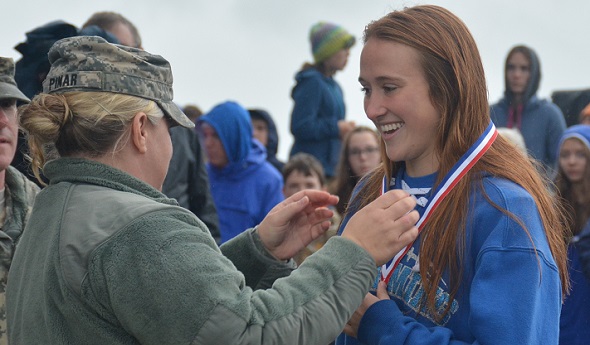
Preview: Champs Favored to Reign Again
October 21, 2016
By Geoff Kimmerly
Second Half editor
The Upper Peninsula’s dominant girls cross country programs will be looking to add to those legacies Saturday at Gladstone’s Beauchamp Cross Country Course.
 Marquette is seeking its fourth straight title in Division 1, while Ishpeming in Division 2 and Chassell in Division 3 have both won two straight MHSAA Finals championships.
Marquette is seeking its fourth straight title in Division 1, while Ishpeming in Division 2 and Chassell in Division 3 have both won two straight MHSAA Finals championships.
Races begin Saturday with the Division 1 boys at 11 a.m. and finish with the Division 3 girls at 2 p.m. Check back Saturday evening for coverage of all six Upper Peninsula Finals, and see below for more teams and individuals to watch. The MHSAA Cross Country Finals are sponsored by the Michigan National Guard.
DIVISION 1
Reigning champion: Marquette
2015 runner-up: Sault Ste. Marie
2016 top three: 1. Marquette, 2. Sault Ste. Marie, 3. Menominee.
The Redettes graduated some serious firepower after winning their third straight championship last season, including individual winner Lindsey Rudden and fifth-place Holly Blowers. But seniors Becci McNamee (seventh last season) and Amber Huebner (nine) are back to anchor a team that total brings to this weekend four who finished among the top 21 in 2015 plus standout freshmen Erica Asmus and Reegin Katzenberger. Asmus finished first at the Great Northern Conference championship race, followed by Huebner and McNamee. Sault Ste. Marie’s top five from last season’s Final should lead the strongest challenge – junior Mackenzie Kalchik, who finished fourth last year, plus sophomore Megan Arbic (sixth), senior Courtney Arbic (eighth), junior Rebekka Ranta (15th) and senior Josie Roos (16th). The Blue Devils also have a pair of standout freshmen in Nicky Kucharczyk and Shelby Eavou.
Individuals: A trio of contenders join the other six mentioned above who finished among the top 15 last season. Negaunee junior Clara Johnson is the reigning Division 1 runner-up after finishing only six seconds behind Rudden in 2015. Gladstone’s Leigha Woelffer was 10th last season – but won Division 1 in 2014 – and Kingsford’s Peyton Johnson was 12th in 2015. Johnson, a sophomore, finished fourth behind the three Marquette placers at the GNC final two weeks ago, and Woelffer, a senior, was sixth. Manistique sophomore Ashley McDonald was eighth in Division 2 last season.
DIVISION 2
Reigning champion: Ishpeming
2015 runner-up: Hancock
2016 top three: 1. Ishpeming, 2. Munising, 3. Hancock.
The Hematites are significant favorites with six of their top seven – who all placed 22nd or better – back this weekend. They’re led by reigning individual champion and senior Khora Swanson, followed by junior Mariah Bertucci (third), junior Kayla Kaukola (sixth), sophomore Brooke Johnson (ninth), junior Chloe Sjoholm (17th) and junior Katie Loman (22nd). Munising was last season’s Division 3 runner-up and could challenge with five of their top seven back including juniors Alyssa Webber (third in D3), sophomore Madeline Peramaki (sixth) and junior Sami Coyne (19th). Hancock was second to Ishpeming last year in Division 2 and brings back top-20 finishers Allyson Fenton (19th) and Greta Berg (20th), both juniors.
Individuals: Joining the Ishpeming crew are four others who finished among the top 15 last season – Gogebic junior Melissa Wanink (fourth) and senior Lily Wieringa (14th), St. Ignace senior Callie Kammers (10th) and Ironwood senior Corissa Mattson (15th). Also, Newberry senior Maysa Sitar was 15th in Division 3. Swanson won last season’s race by 19 seconds, but Wanink was only a second behind Bertucci for third place. Munising’s Webber ran an impressive 20:02 at the Holly Invitational in September to beat that mostly downstate field by eight seconds.
DIVISION 3
Reigning champion: Chassell
2015 runner-up: Munising
2016 top three: 1. Chassell, 2. Cedarville, 3 Stephenson.
Top-ranked Chassell won’t have to worry about Munising this season after finishing only two points better to win last year’s title, but has another experienced contender to watch. Sophomore Lela Rautiola is coming off a seventh-place finish at least season’s Final and has been in the mix among the Upper Peninsula’s best, regardless of division. Jenna Pietila (21st) and Briah Maki (27th) also are back as sophomores after running in the team’s top five. Cedarville senior Emma Bohn was fourth last season and leads a team bringing back all seven runners, including also 14th-place senior Leila Schlosser, after finishing third in 2015. Stephenson is looking to move up from sixth last season while returning four of its top six.
Individuals: Bohn is the highest returning placer, and in addition to her teammate Schlosser and the Chassell leaders will also have to watch for Brimley juniors Lauren Halvorsen and Hannah Lyons. They finished fifth and ninth, respectively, at the 2015 Final.
PHOTO: Ishpeming's Khora Swanson (right) receives her championship medal last season from a member of the Michigan National Guard.

MHSAA Vault: MIS Rose to Challenges to Host 2020 LP Finals
By
Rob Kaminski
MHSAA benchmarks editor
November 12, 2021
The “MHSAA Vault” features stories from past publications and other documents in the MHSAA Library. This issue takes a look at the MHSAA Cross Country Finals at Michigan International Speedway, which celebrated 25 years in 2020 – although it was an event that nearly didn’t happen last fall …
In 1996, the MHSAA and Michigan International Speedway began a partnership the changed the course of the Lower Peninsula Cross Country Finals – quite literally.
The land in and around the track at Brooklyn would host the Finals for all classes of runners in one place on one day, an annual festival of nearly 2,000 runners competing for the MHSAA’s top honors.
Even skeptics – and there were several among running purists who thought the course was too flat, for example – can’t deny the results.
Finals attendance nearly doubled in that first year, and crowds in excess of 10,000 have enjoyed a day of racing several times, including a record 12,153 in 2011.
Enthusiastic crowds were the norm in recent years, with 11,232 in 2017, and nearly 11,000 in 2018 (10,989) and 2019 (10,873).
In fact, attendance failed to reach at least 8,000 only twice since the move to MIS.
Of course, last year was an exception, when attendance was limited to 1,000 spectators per session due to the COVID-19 Pandemic. Fans also were restricted to the grandstands rather than following the action throughout locations on the course.
To reduce the number of runners in each race, the event was spread over two days, with each Division being run in two separate “sections” with times then combined at the end to determine team and individual champions.
While not ideal, the end result was another year of fantastic efforts at MIS – both from student-athletes and those behind the scenes.
“Even at the last hour, less than a week ahead of the Finals, we were closer to not having the Finals than we were to having them,” said MHSAA Assistant Director Cody Inglis, who coordinates the cross country postseason. “Rumors and challenges of mandated shutdowns, testing and other requirements were being discussed and caused a lot of unknowns. Even at the Regional level, we had schools, Regional courses and hosts shutting down their facilities; we had to relocate four Regionals 48 hours prior to race times. That scenario just could not happen at the Finals level where far more runners and much more travel would be involved.”
Among the many last-minute hurdles was the edict from NASCAR – which owns MIS – that all persons on site be temperature checked upon entry. That meant securing thermometers that were easy to operate in short order, along with personnel necessary to conduct the readings.
The attendance limitations certainly helped to implement the temperature screening, but brought their own issues.
“Limiting spectators was not a popular decision, but it really was the only way to have a race,” Inglis said. “We were taking direction and working with policies and protocols from the MDHHS, the Governor’s office, Lenawee County Health Department, MIS and NASCAR.”
Part of the solution was to utilize the grandstands as a “barrier” between participants and spectators. The reduced number of fans were dispersed over thousands of seats while still allowing them the chance to watch their student-athletes compete.
“It wasn’t the same, it wasn’t easy or perfect, but it was what we had to do to have a race,” Inglis said. “Separating the Finals into two days and different sections also allowed us to spread out the event and limit the number of people on site at any one time. This was a key part of the plan and worked well even though it separated races within a Division.”
The MHSAA, MIS and the cross country community never lost focus of the main goal: a culmination of the season for the student-athletes, who deserved something last year more than ever. And, more than ever, MIS once again displayed its advantage as a venue that could adapt to the fluid nature of the times to pull off the event.
“There were some thoughts of using four different sites, but as we learned during the Regionals, the climate of things was so tenuous from one area of the state to another that we couldn’t be 100-percent certain that there wouldn’t again be last-minute cancelations,” Inglis said. “MIS was wonderful to work and collaborate with, and was the best option to get it done. It was never mentioned once publicly about the possibility of not having the Finals – only how we could best do it under uncharted conditions.”
The moving parts and ever-changing scenarios created more complexity than ever in finalizing a season, but every decision was made with the complete desire to conduct the Finals as close to normal as possible.
“I firmly believe that a finish to the season, no matter the differences in race formatting and fan experience, was something everyone would have taken when the season began in August,” Inglis said.
Indeed, the finish line in Year 25 at MIS might have been the most gratifying of them all.

